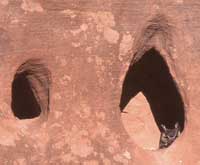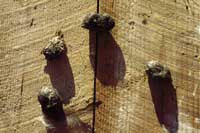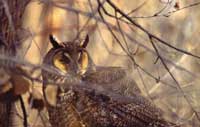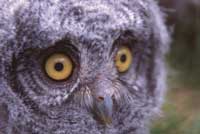 Locating owls in Canyon Country is more by sound than sight. The occasional great horned owl flushed off a roost or one floating across the road in front of headlights is one thing, but the chance of actually seeing an owl is slim.
Locating owls in Canyon Country is more by sound than sight. The occasional great horned owl flushed off a roost or one floating across the road in front of headlights is one thing, but the chance of actually seeing an owl is slim.
However, of the eight or nine species that occur in the Moab area, the great horned owl is the most commonly observed. Its large size and deep who’s awake? Me too call is one of the classic canyon wildlife encounters. The deep baritone notes can be heard a mile away during the stillness of night.
Large in size and sporting long ear tufts, these owls nest in abandoned hawk or raven nests, on ledges or in alcoves eroded into canyon walls. They prey upon a variety of small mammals, rodents and birds, with cottontails and jackrabbits high on that list. Mice, squirrels, skunks, ducks, quail, geese – if it walks or waddles it is fair game to these owls. Even peregrine falcons, especially their nestlings, may fall prey to these nocturnal predators.
February is a good month to try and locate the great horned because they are either already nesting or calling to establish pair bonds and defend territories. Hiking along the canyon bottoms, I’ll look for large stick nests in the cottonwoods, their  presence easy to find due to the lack of foliage hiding the nest. I’ll also investigate pockets worn into the sandstone for a roosting or nesting owl. Also the bird’s large size and bulky shape makes them a bit more obvious even in silhouette.
presence easy to find due to the lack of foliage hiding the nest. I’ll also investigate pockets worn into the sandstone for a roosting or nesting owl. Also the bird’s large size and bulky shape makes them a bit more obvious even in silhouette.
The other clue I look for are the regurgitated pellets than contain the bones and fur of the owl’s last meal. Often these pellets will pile up beneath a favorite perch. Interesting in themselves, the pellets may contain insect wings, scorpion pieces, intact skulls or other bones that provide information about who the owl has preyed upon.
 But the great horned isn’t the only owl to inhabit these canyons. Long-eared and western screech-owls are two other “eared” species that occur here. The long-eared is a medium sized owl that has an orangish facial disk and ear tufts that are set close together. These owls will also use an abandoned crow or hawk nest for their own, and may be found roosting together in winter in willow and tamarisk thickets. The long-eared owl’s deep whoooot is a distinct call, but these owls also give barks or cat-like hisses.
But the great horned isn’t the only owl to inhabit these canyons. Long-eared and western screech-owls are two other “eared” species that occur here. The long-eared is a medium sized owl that has an orangish facial disk and ear tufts that are set close together. These owls will also use an abandoned crow or hawk nest for their own, and may be found roosting together in winter in willow and tamarisk thickets. The long-eared owl’s deep whoooot is a distinct call, but these owls also give barks or cat-like hisses.
Like the great horned, the long-eared is big enough to be noticed when perched. If discovered, the birds may stand more erect and raise their ear tufts to try and resemble a stout branch.
 The smaller western screech-owl is harder to locate due to its size. Perched on a tree limb or sitting in the crook of a tree, they blend in with their surroundings. However, during February, these owls often broadcast their distinct call which is a series of hollow, whistled notes that accelerates towards the end and may end in a rapid trill.
The smaller western screech-owl is harder to locate due to its size. Perched on a tree limb or sitting in the crook of a tree, they blend in with their surroundings. However, during February, these owls often broadcast their distinct call which is a series of hollow, whistled notes that accelerates towards the end and may end in a rapid trill.
Nesting in tree cavities or in nest boxes, these small owls have little ear tufts. Like the long-eared owls, when disturbed these birds stretch themselves upwards trying to resemble a branch.
Feeding on small rodents, birds, lizards and even amphibians, the screech owl takes advantage of a wide range of prey.
So even though February may seem quiet in terms of birds singing, one just needs to shift their attention to those species that call in the dark of night.